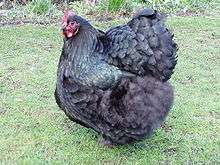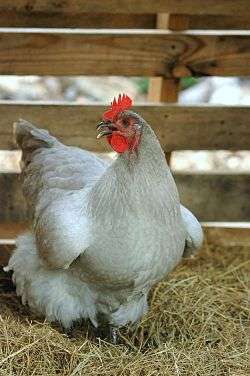Orpington chicken
 A Black Orpington hen | |
| Country of origin | United Kingdom |
|---|---|
| Standard | The Orpington Club (UK) |
| Traits | |
| Weight | Male: 8–15 kg[1] |
| Female: 2.70–3.60 kg | |
| Skin color | White |
| Egg color | Light brown |
| Comb type | Medium Single |
| Classification | |
| APA | English |
| PCGB | Soft Feather: Heavy[2] |
|
Chicken Gallus gallus domesticus | |
The Orpington is a breed of chicken named after the town of Orpington, Kent, in south-east England,[3]:115 which was made famous in part by this breed. It was bred to be an excellent layer with good meat quality.[3]:115 Its large size and soft appearance together with its rich colour and gentle contours make it very attractive, and as such its popularity has grown as a show bird rather than a utility breed. Hens often become broody and are good mothers. Although rather heavy, they are able to fly small distances but rarely do so.[4]:158
History
The original Black Orpington was bred by William Cook in 1886 by crossing Minorcas, Langshans and Plymouth Rocks to create a new hybrid bird. Cook selected a black bird that would exhibit well by hiding the dirt and soot of London.[4]:158 When the breed was shown in Madison Square Gardens in 1895, its popularity soared.[3]:115 Cook also bred the Orpington Duck.[5]:74
The original colours are black, white, buff, blue and splash. Although there are many additional varieties recognised throughout the world, only the original colours are recognised by the American Standard, the Buff being the most common colour.[6]:98 In the beginning of the twentieth century, Herman Kuhn of Germany developed a Bantam variety.[4]:254 The Bantam retains the appearance of the full-size bird, but in a smaller size. There is a large variety of colours in the Bantam version, including black, blue laced, white, buff, red, buff black laced, barred, buff Columbian, and birchen.[4]:254 The Bantam retains the friendly personality of the Standard breed, and seldom or never flies.[4]:254
In the UK club dedicated to the breed is the Orpington Club, which merged with the Orpington Bantam Club in 1975. The United Orpington Club is the American breeder's club, and the Orpington Club of Australia is the Australian club for the breed.
Characteristics

There are two similar but different standards for Orpingtons. The first is published by the Poultry Club of Great Britain and asks for a weight from 3.60 to 4.55 kg for cocks and 2.70 to 3.60 kg for hens.[1] They also ask for a heavy, broad body with a low stance, with fluffed-out feathers which make it look large; the down from the body covers most of the legs. Other characteristics of their Orpingtons are a curvy shape with a short back and U-shaped underline, and a small head with a medium single comb.
Use
Orpingtons lay about 175 to 200[4]:158 medium to large[3]:115 light-brown eggs a year.
It was said that at one time Orpingtons were capable of laying as many as 340[3]:115 eggs per year. This decline in production was due to breeders selecting for looks over utility.[6]:98
References
- 1 2 The Orpington Breed Standards. The Orpington Club. Accessed August 2014.
- ↑ Breed Classification. Poultry Club of Great Britain. Accessed August 2014.
- 1 2 3 4 5 Pam Percy (2006). The Field Guide to Chickens. St. Paul, Minnesota: Voyageur Press. ISBN 9780760324738.
- 1 2 3 4 5 6 Esther Verhoff (2003). The Complete Encyclopedia of Chickens. Lisse, Netherlands: Rebo International. ISBN 9789036615921.
- ↑ Dave Holderread (2011). Storey's Guide to Raising Ducks, 2nd edition. North Adams, Massachusetts: Storey Publishing. ISBN 9781603427456.
- 1 2 Carol Ekarius (2007). Storey's Illustrated Guide to Poultry Breeds. North Adams Massachusetts: Storey Publishing. ISBN 9781580176675.